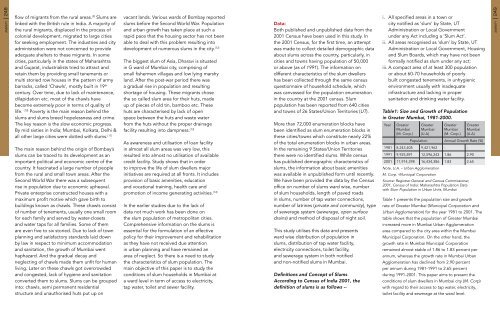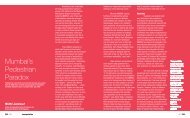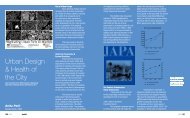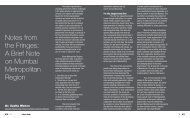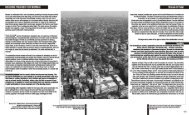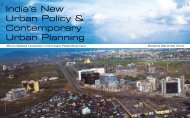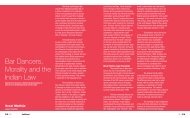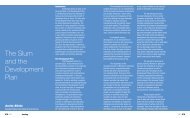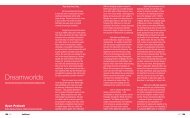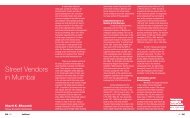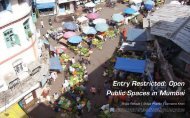Access to Civic Amenities in Slums of Mumbai.pdf - Urban Design ...
Access to Civic Amenities in Slums of Mumbai.pdf - Urban Design ...
Access to Civic Amenities in Slums of Mumbai.pdf - Urban Design ...
- No tags were found...
You also want an ePaper? Increase the reach of your titles
YUMPU automatically turns print PDFs into web optimized ePapers that Google loves.
AMENITY | 248flow <strong>of</strong> migrants from the rural areas. (9) <strong>Slums</strong> arel<strong>in</strong>ked with the British rule <strong>in</strong> India. A majority <strong>of</strong>the rural migrants, displaced <strong>in</strong> the process <strong>of</strong>colonial development, migrated <strong>to</strong> large citiesfor seek<strong>in</strong>g employment. The <strong>in</strong>dustries and cityadm<strong>in</strong>istration were not concerned <strong>to</strong> provideadequate shelters <strong>to</strong> these migrants. In somecities, particularly <strong>in</strong> the states <strong>of</strong> Maharashtraand Gujarat, <strong>in</strong>dustrialists tried <strong>to</strong> attract andreta<strong>in</strong> them by provid<strong>in</strong>g small tenements ormulti s<strong>to</strong>ried row houses <strong>in</strong> the pattern <strong>of</strong> armybarracks, called ‘Chawls’, mostly built <strong>in</strong> 19 thcentury. Over time, due <strong>to</strong> lack <strong>of</strong> ma<strong>in</strong>tenance,dilapidation etc. most <strong>of</strong> the chawls havebecome extremely poor <strong>in</strong> terms <strong>of</strong> quality <strong>of</strong>life. (10) Poverty is the ma<strong>in</strong> reason beh<strong>in</strong>d theslums and slums breed hopelessness and crime.The key reason is the slow economic progress.By mid sixties <strong>in</strong> India; <strong>Mumbai</strong>, Kolkata, Delhi &all other large cities were dotted with slums. (11)The ma<strong>in</strong> reason beh<strong>in</strong>d the orig<strong>in</strong> <strong>of</strong> Bombay’sslums can be traced <strong>to</strong> its development as animportant political and economic centre <strong>of</strong> thecountry. It fasc<strong>in</strong>ated a large number <strong>of</strong> peoplefrom the rural and small <strong>to</strong>wn areas. After theSecond World War there was a subsequentrise <strong>in</strong> population due <strong>to</strong> economic upheaval.Private enterprise constructed houses with amaximum pr<strong>of</strong>it motive which gave birth <strong>to</strong>build<strong>in</strong>gs known as chawls. These chawls consis<strong>to</strong>f number <strong>of</strong> tenements, usually one small roomfor each family and served by water-closetsand water taps for all families. Some <strong>of</strong> themare even five <strong>to</strong> six s<strong>to</strong>ried. Due <strong>to</strong> lack <strong>of</strong> <strong>to</strong>wnplann<strong>in</strong>g and satisfac<strong>to</strong>ry standards laid downby law <strong>in</strong> respect <strong>to</strong> m<strong>in</strong>imum accommodationand sanitation, the growth <strong>of</strong> <strong>Mumbai</strong> wenthaphazard. And the gradual decay andneglect<strong>in</strong>g <strong>of</strong> chawls made them unfit for humanliv<strong>in</strong>g. Later on these chawls got overcrowdedand congested, lack <strong>of</strong> hygiene and sanitationconverted them <strong>to</strong> slums. <strong>Slums</strong> can be grouped<strong>in</strong><strong>to</strong>: chawls, semi permanent residentialstructure and unauthorised huts put up onvacant lands. Various wards <strong>of</strong> Bombay reportedslums before the Second World War. Populationand urban growth has taken place at such arapid pace that the hous<strong>in</strong>g sec<strong>to</strong>r has not beenable <strong>to</strong> deal with this problem result<strong>in</strong>g <strong>in</strong><strong>to</strong>development <strong>of</strong> numerous slums <strong>in</strong> the city. (12)The biggest slum <strong>of</strong> Asia, Dharavi is situated<strong>in</strong> G ward <strong>of</strong> <strong>Mumbai</strong> city, compris<strong>in</strong>g <strong>of</strong>small fishermen villages and low ly<strong>in</strong>g marshyland. After the post-war period there wasa gradual rise <strong>in</strong> population and result<strong>in</strong>gshortage <strong>of</strong> hous<strong>in</strong>g. These migrants chosethe so called slum area for their huts, madeup <strong>of</strong> pieces <strong>of</strong> old t<strong>in</strong>, bamboo etc. Thesehuts are characterised by lack <strong>of</strong> openspace between the huts and waste waterfrom the huts without the proper dra<strong>in</strong>agefacility result<strong>in</strong>g <strong>in</strong><strong>to</strong> dampness. (13)As awareness and utilisation <strong>of</strong> loan facility<strong>in</strong> almost all slum areas was very low, thisresulted <strong>in</strong><strong>to</strong> almost no utilisation <strong>of</strong> availablecredit facility. Study shows that <strong>in</strong> order<strong>to</strong> improve the life <strong>of</strong> slum dwellers major<strong>in</strong>itiatives are required at all fronts. It <strong>in</strong>cludesprovision <strong>of</strong> basic amenities, educationand vocational tra<strong>in</strong><strong>in</strong>g, health care andpromotion <strong>of</strong> <strong>in</strong>come generat<strong>in</strong>g activities. (14)In the earlier studies due <strong>to</strong> the lack <strong>of</strong>data not much work has been done onthe slum population <strong>of</strong> metropolitan cities.Comprehensive <strong>in</strong>formation on the slums isessential for the formulation <strong>of</strong> an effectivepolicy for their improvement and rehabilitationas they have not received due attention<strong>in</strong> urban plann<strong>in</strong>g and have rema<strong>in</strong>ed anarea <strong>of</strong> neglect. So there is a need <strong>to</strong> studythe characteristics <strong>of</strong> slum population. Thema<strong>in</strong> objective <strong>of</strong> this paper is <strong>to</strong> study theconditions <strong>of</strong> slum households <strong>in</strong> <strong>Mumbai</strong> ata ward level <strong>in</strong> term <strong>of</strong> access <strong>to</strong> electricity,tap water, <strong>to</strong>ilet and sewer facility.Data:Both published and unpublished data from the2001 Census have been used <strong>in</strong> this study. Inthe 2001 Census, for the first time, an attemptwas made <strong>to</strong> collect detailed demographic dataabout slums across the country, particularly, <strong>in</strong>cities and <strong>to</strong>wns hav<strong>in</strong>g population <strong>of</strong> 50,000or above (as <strong>of</strong> 1991). The <strong>in</strong>formation ondifferent characteristics <strong>of</strong> the slum dwellershas been collected through the same censusquestionnaire <strong>of</strong> household schedule, whichwas canvassed for the population enumeration<strong>in</strong> the country at the 2001 census. Slumpopulation has been reported from 640 citiesand <strong>to</strong>wns <strong>of</strong> 26 States/Union Terri<strong>to</strong>ries (UT).More than 72,000 enumeration blocks havebeen identified as slum enumeration blocks <strong>in</strong>these cities/<strong>to</strong>wns which constitute nearly 22%<strong>of</strong> the <strong>to</strong>tal enumeration blocks <strong>in</strong> urban areas.In the rema<strong>in</strong><strong>in</strong>g 9 States/Union Terri<strong>to</strong>riesthere were no identified slums. While censushas published demographic characteristics <strong>of</strong>slums, the <strong>in</strong>formation about basic amenitieswas available <strong>in</strong> unpublished form until recently.We have been provided the data by the Census<strong>of</strong>fice on number <strong>of</strong> slums ward wise, number<strong>of</strong> slum households, length <strong>of</strong> paved roads<strong>in</strong> slums, number <strong>of</strong> tap water connections,number <strong>of</strong> latr<strong>in</strong>es (private and community), type<strong>of</strong> sewerage system (sewerage, open surfacedra<strong>in</strong>s) and method <strong>of</strong> disposal <strong>of</strong> night soil.This study utilises this data and presentsward wise distribution <strong>of</strong> population <strong>in</strong>slums, distribution <strong>of</strong> tap water facility,electricity connections, <strong>to</strong>ilet facility,and sewerage system <strong>in</strong> both notifiedand non-notified slums <strong>in</strong> <strong>Mumbai</strong>.Def<strong>in</strong>itions and Concept <strong>of</strong> <strong>Slums</strong>Accord<strong>in</strong>g <strong>to</strong> Census <strong>of</strong> India 2001, thedef<strong>in</strong>ition <strong>of</strong> slums is as follows --i. All specified areas <strong>in</strong> a <strong>to</strong>wn orcity notified as ‘slum’ by State, UTAdm<strong>in</strong>istration or Local Governmentunder any Act <strong>in</strong>clud<strong>in</strong>g a ‘Slum Act’.ii. All areas recognised as ‘slum’ by State, UTAdm<strong>in</strong>istration or Local Government, Hous<strong>in</strong>gand Slum Boards, which may have not beenformally notified as slum under any act;iii. A compact area <strong>of</strong> at least 300 populationor about 60-70 households <strong>of</strong> poorlybuilt congested tenements, <strong>in</strong> unhygienicenvironment usually with <strong>in</strong>adequate<strong>in</strong>frastructure and lack<strong>in</strong>g <strong>in</strong> propersanitation and dr<strong>in</strong>k<strong>in</strong>g water facility.Table1: Size and Growth <strong>of</strong> Population<strong>in</strong> Greater <strong>Mumbai</strong>, 1981-2000.YearGreater<strong>Mumbai</strong>(M. Corp.)Greater<strong>Mumbai</strong>(U.A)Greater<strong>Mumbai</strong>(M. Corp.)Greater<strong>Mumbai</strong>(U.A)Population Annual Growth Rate (%)1981 8,243,405 9,421,962 - -1991 9,925,891 12,596,243 1.86 2.902001 11,914,398 16,434,386 1.83 2.65Note. U.A. – <strong>Urban</strong> AgglomerationM. Corp. -Municipal CorporationSource: Registrar General and Census Commissioner,2001, Census <strong>of</strong> India: Maharashtra Population Datawith Slum Population <strong>in</strong> <strong>Urban</strong> Units, <strong>Mumbai</strong>Table 1 presents the population size and growthrate <strong>of</strong> Greater <strong>Mumbai</strong> (Municipal Corporation and<strong>Urban</strong> Agglomeration) for the year 1981 <strong>to</strong> 2001. Thetable shows that the population <strong>of</strong> Greater <strong>Mumbai</strong><strong>in</strong>creased more <strong>in</strong> <strong>Mumbai</strong> <strong>Urban</strong> Agglomerationarea compared <strong>to</strong> the city area with<strong>in</strong> the <strong>Mumbai</strong>Municipal Corporation. On the other hand, thegrowth rate <strong>in</strong> <strong>Mumbai</strong> Municipal Corporationrema<strong>in</strong>ed almost stable <strong>of</strong> 1.86 <strong>to</strong> 1.83 percent perannum, whereas the growth rate <strong>in</strong> <strong>Mumbai</strong> <strong>Urban</strong>Agglomeration has decl<strong>in</strong>ed from 2.90 percentper annum dur<strong>in</strong>g 1981-1991 <strong>to</strong> 2.65 percentdur<strong>in</strong>g 1991-2001. This paper aims <strong>to</strong> present theconditions <strong>of</strong> slum dwellers <strong>in</strong> <strong>Mumbai</strong> city (M. Corp)with regard <strong>to</strong> their access <strong>to</strong> tap water, electricity,<strong>to</strong>ilet facility and sewerage at the ward level.AMENITY | 249


